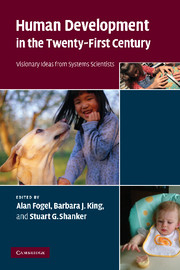Book contents
- Frontmatter
- Contents
- List of contributors
- Introduction: Why a dynamic systems approach to fostering human development?
- Part I Dynamic relationships between genetics and environments
- Part II The dynamic system of the child in the family
- Part III The dynamic system of the child in social and physical environment
- Part IV Dynamic systems approaches to mental health
- 17 A dynamic developmental model of mental health and mental illness
- 18 Dyadic microanalysis of mother–infant communication informs clinical practice
- 19 Current problems of Japanese youth: some possible pathways for alleviating these problems from the perspective of dynamic systems theory
- 20 A different way to help
- 21 Why do siblings often turn out very differently?
- 22 A dynamic systems approach to understanding family and peer relationships: implications for effective interventions with aggressive youth
- 23 Prenatal substance exposure and human development
- Part V Conclusions and outlook
- Index
- References
18 - Dyadic microanalysis of mother–infant communication informs clinical practice
Published online by Cambridge University Press: 22 September 2009
- Frontmatter
- Contents
- List of contributors
- Introduction: Why a dynamic systems approach to fostering human development?
- Part I Dynamic relationships between genetics and environments
- Part II The dynamic system of the child in the family
- Part III The dynamic system of the child in social and physical environment
- Part IV Dynamic systems approaches to mental health
- 17 A dynamic developmental model of mental health and mental illness
- 18 Dyadic microanalysis of mother–infant communication informs clinical practice
- 19 Current problems of Japanese youth: some possible pathways for alleviating these problems from the perspective of dynamic systems theory
- 20 A different way to help
- 21 Why do siblings often turn out very differently?
- 22 A dynamic systems approach to understanding family and peer relationships: implications for effective interventions with aggressive youth
- 23 Prenatal substance exposure and human development
- Part V Conclusions and outlook
- Index
- References
Summary
Our research began in the 1960s with the study of adult dialogue by Joseph Jaffe and Stanley Feldstein. Our interest was in features of speech rhythms relevant to the communication of mood, the phenomenon of empathy, and the breakdown of effective dialogue. Speech rhythms include turn-taking, pausing, and interrupting. By the late 1960s, when Daniel Stern and Beatrice Beebe joined the team, our interests widened to the study of mother–infant dialogues. Since then, the analysis of speech rhythms has been expanded to analogous rhythms of many modalities (gaze, vocal quality, facial expression, touching, head movement, and posture).
This dyadic “microanalysis” research looks at the joint behaviors of two people. It operates like a microscope, identifying in detail the instant-by-instant interactive events which are so fast and subtle that they are usually lost to the naked eye (ear), and operate largely out of awareness. The analysis of different modalities of communication operates like the stains lighting up different coexisting structures under the microscope. Using this approach we discovered that maternal depression affected facial expression and gaze direction in opposite ways: mothers and infants were vigilant to each other's facial shifts, but withdrawn from monitoring each other's visual availability, as we describe in detail below.
The discoveries made with this research have tremendous implications for early intervention in mother–infant communication disturbances. Both embodying the unusual combination of researcher and psychoanalyst, Beebe and Jaffe are intensely concerned with translating research findings into clinical interventions.
- Type
- Chapter
- Information
- Human Development in the Twenty-First CenturyVisionary Ideas from Systems Scientists, pp. 176 - 187Publisher: Cambridge University PressPrint publication year: 2007
References
- 2
- Cited by

